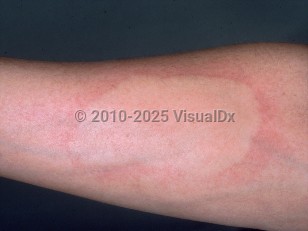Cold urticaria in Child
Alerts and Notices
Important News & Links
Synopsis

Wheals are usually localized to the area of contact, but they may be more generalized in the setting of extensive cold exposure. Systemic symptoms of flushing, headache, syncope, and abdominal pain may also develop if large areas are affected, such as after aquatic activities. One large study found that onset of cold urticaria in childhood was associated with systemic symptoms after immersion in cold water. Angioedema may be a feature, and of the chronic inducible urticarias, this subtype is one of the more common to be complicated by anaphylaxis. Some studies have found that over one-third of individuals with cold urticaria also experience anaphylactic reactions to cold. Individuals with the shortest time to onset of wheals often have more severe symptoms, with onset in less than 3 minutes being associated with a higher risk of hypotensive episodes. One large study identified angioedema, oropharyngeal involvement, and itchy earlobes to be risk factors for cardiovascular manifestations of cold urticaria.
Cold urticaria is less common among the pediatric population than among adults, but it has been seen in children as young as 6 months. Girls are more commonly affected than boys. Primary acquired cold urticaria is the most common form of cold urticaria seen in children. Cold urticaria due to underlying conditions, such as infection, cryoglobulinemia, cryofibrinogenemia, or lymphoproliferative diseases, is especially rare in children.
Familial cold autoinflammatory syndrome (FCAS) is a subtype of cryopyrin-associated periodic syndrome (CAPS). FCAS typically presents within the first 6 months of life with recurrent outbreaks of fever, arthralgia, fatigue, and nonpruritic urticaria that occurs after cold exposure. Systemic findings such as conjunctivitis, myalgia, and nausea may also be seen. Rarely, patients may experience headache, diaphoresis, drowsiness, and amyloidosis. Symptoms begin 10 minutes to 8 hours after cold exposure and generally subside within 24 hours. The time to resolution may be longer in cases of more prolonged cold exposure.
Codes
L50.2 – Urticaria due to cold and heat
SNOMEDCT:
74774004 – Cold urticaria
Look For
Subscription Required
Diagnostic Pearls
Subscription Required
Differential Diagnosis & Pitfalls

Subscription Required
Best Tests
Subscription Required
Management Pearls
Subscription Required
Therapy
Subscription Required
Drug Reaction Data
Subscription Required
References
Subscription Required
Last Updated:02/17/2022

